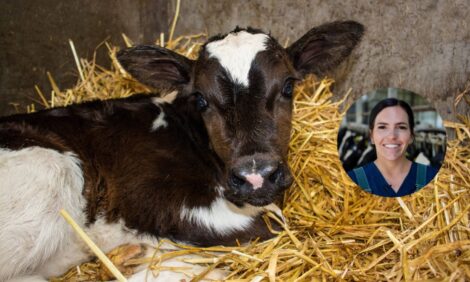



Aureomycin and Zinc Reduce Incidence of Foot Rot in Grass Cattle
Despite an occasional respiratory problem, the major health-related cost that stocker producers will experience with grazing calves are performance losses and treatment costs associated with foot rot, writes Dale A. Blasi, beef specialist, K-State University.Now is a good time to consider management strategies that will minimize health issues and improve grazing performance.
Foot rot is a sub-acute or acute necrotic infectious disease caused by the entry of bacteria (primarily Fusobacterium necrophorum) through damage to the soft tissues between the toes and sole which become traumatized by rocks, dried mud and stubble.
Lameness is the primary symptom but there are a number of reasons why calves may become lame. Many veterinarians advise to inspect for the presence of foreign objects before assigning a diagnosis of foot rot. However, equal swelling above the hoof line and dew claws and the presence of a foul odor is almost a sure sign of foot rot.
The incidence of foot rot while on pasture can be sporadic and may often affect up to 25 per cent of calves within a pasture. Its occurrence is dependent upon the interaction of several factors: the presence of the right conditions for bacteria to invade, the particular animal, management practices and finally, environmental factors. In many cases, excessive moisture and alternate drying conditions promote skin cracking in the interdigital space.
These environmental conditions, coupled with injury to the soft tissue, promote conditions which are conducive for the bacteria to invade and flourish. If treatment is delayed, foot rot can become chronic with a poorer prognosis for recovery because deeper structures within the toe may become infected.
Unfortunately, by the time clinical symptoms are observed and the calf treated, gain may have already been sorely compromised.
Given the extensive nature of grazing programs, frequency of observation and the labor costs associated with treatment on pasture, many producers have resorted to the provision of sub-therapeutic levels of antibiotics in mineral mixes. However there is little data to substantiate the effectiveness. In addition, there is an ongoing debate on the relationship between the use of subtherapeutic antibiotics in livestock and the perceived increase in human resistance to antibiotics.
Research at the KSU Beef Stocker Unit would indicate cost of treatment could approximate $100 per foot rot episode when accounting for antibiotic, labor and lost performance. This estimate does not account for the potential risk of injury to the rider(s) during the process of treatment in the pasture. With the use of sub-clinical antibiotics, stocker operators are proactively minimizing the occurrence of these noxious infections and in many cases, avoiding the unnecessary stress that both the manager and calf must endure when treatment is warranted for either foot rot or pinkeye.
The KSU Beef Stocker Unit has conducted research with pasture mineral supplements to control foot rot and pink eye over the past two years with Aureomycin (trade name for chlortetracycline) and ionophores (Bovatec and Rumensin) to evaluate health and productivity responses during a spring/ summer grazing season. Two free-choice mineral supplements that contained either Bovatec and Aureomycin (BA) or Rumensin (RU) were compared.
Although the consumption of the RU mineral was significantly less than BA throughout the entire 90 day grazing season, there were no differences between the two treatments with respect to cattle gain.
However, there was a significant reduction in the incidence of foot rot for those pastures that received the BA mineral (4.68 vs 16.88 per cent). In another study, calves receiving Aureomycin alone compared to Aureomycin and Bovatec gained 7 pounds less per calf in a 90 day grazing period. Zinc is a trace element important for maintaining skin and hoof integrity. Many field trials have evaluated zinc supplementation strategies with varied success.
A K-State field trial (Brazle, 1993) was conducted over three grazing seasons with crossbred steers averaging almost 600 pounds. The cattle were allotted to groups provided either a control or a zinc methionine-containing mineral supplement while grazing burned, native Flint Hills pasture.
The addition of 100 pounds of Zinpro 100J (50 per cent zinc methionine) per ton of free-choice mineral improved steer daily gain by almost 0.10 pounds and reduced foot rot by 55 per cent (5.38 vs. 2.45 per cent). Approximately 20 per cent of the live weight gain advantage was attributed to the control of foot rot alone, while the remaining fraction to a zinc deficiency.
Because of substantial cost differences between organic and inorganic minerals, producers have wondered if an inorganic source of zinc such as zinc oxide would promote a similar response? To the author=s knowledge, there have been no replicated trials conducted to answer this particular question.
Another management option that has been on the market for a relatively short period of time is the availability of a commercial vaccine (Fusogard® ) which has been approved for use in cattle as a control for foot rot and liver abscesses.
To evaluate its effectiveness, a large scale field trial was conducted at two locations in southwest Kansas to compare the administration of a single two cc dose at the initiation of the grazing season to untreated control calves. The manufacturer recommends two doses for optimal foot rot control.
The 876 head of heifers and steer calves used in the study averaged about 600 lbs across all pastures and were grazed on native grass for 75 to 148 days. All cattle were observed weekly for visible signs of foot rot and other conditions that required medical attention.
While pasture performance was similar between treatments, differences in the incidence of foot rot between the treated and control cattle (.91 vs. 2.28 per cent, respectively) approached significance (P = 0.11).
Foot rot and pink eye are noxious diseases that reduce productivity. Stocker operators who graze calves should anticipate these problems and should consider strategies that prevent their occurrence.
May 2009


